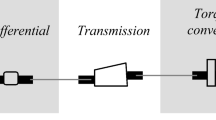Abstract
The performance of a power based fuel consumption and exhaust emissions model for spark ignition vehicles has been evaluated using a large Australian database derived from testing a wide range of in-use cars on a chassis dynamometer. It was also applied to results of on-road fuel consumption measurement using a "floating" car which was driven back and forth on hilly roadways in Sydney with a length of 8.6 km. The model is found to predict the fuel consumption well over the standard drive cycles and also for the floating car. Average exhaust emissions were also well predicted, but, as would be expected, vehicle-to-vehicle correlation is impossible due to the well-known high variability of emissions between nominally identical vehicles.
Similar content being viewed by others
References
Biggs, D.C. and Akcelik, R.:1986, Estimation of car fuel consumption in urban traffic. Proc 13th Australian Road Research Board ARRB Conf. 13(7), 124–132.
Carnovale, F., Alviano, P., Carvalho, C., Deitch, G., Jiang, S., Macaulay, D. and Summers, M.:1991, Air emissions inventory Port Phillip Control Region. EPA (Vic) report SRS 91/001.
Claffey, P.J.:1976, Passenger car fuel conservation. US Fed. Highw. Admin. Rep. No. FHWA-PL-77009. Washington, DC.
Guensler, R., Washington, S., Koenig, B. and Sperling, D.:1993, The impact of speed correction factor uncertainty on mobile source emission inventories in the South Coast. Proc. Int. Speciality Conf. “The Emission Inventory-Perception and Reality”, Air &; Waste Mgt. Assoc.
Post, K., Tomlin, J., Pitt, D., Carruthers, N., Maunder, A., Kent, J.H. and Bilger, R.W.:1981, Fuel Economy and Emissions Res. Report. Charles Kolling Res. Lab., Univ. of Sydney. TN ER-36.
Richardson A.J.:1982, Stop-start fuel consumption rates, Second Conference on Traffic, Energy and Emission, 19-20 May 1982 at the National Science Centre, Melbourne.
Robinson, N.F., Pierson, W.R. and Gerler, A.W.:1993, Comparison of real world CO, VOC and NOx emission rates with motor vehicle emission models. Proc. Int. Speciality Conf. “The En/mission Inventory-Perception and Reality”, Air &; Waste Mgt. Assoc.
Taylor, M.A.P. and Young, T.M.:1996, Fuel consumption and emission models for traffic engineering and transport planning applications. Proc. Roads 96 Conf., Part 6, Christchurch, New Zealand.
Watson, H.C.:1980, Sensitivity of fuel consumption and emissions to driving patterns and vehicle design, SAE Aust. ARRB Conf: Can traffic management reduce fuel consumption and emissions and affect vehicle design requirements, Australia.
Watson, H.C.:1982, Calibration and application of two fuel consumption models. In: R. Akcelik (Ed). Fuel consumption modelling for urban traffic management, Australian Road Research Board, Research Report No. 124.
Williams D.J., Shenouda D.A. and Carras J.N.:1994, Modelling air toxic emissions from motor vehicles. Proc. 1994 Air Toxics Conf., Aug. 1994 at National Measurement Lab., Sydney. 29
Author information
Authors and Affiliations
Rights and permissions
About this article
Cite this article
Leung, D., Williams, D. Modelling of Motor Vehicle Fuel Consumption and Emissions Using a Power-Based Model. Environ Monit Assess 65, 21–29 (2000). https://doi.org/10.1023/A:1006498328936
Issue Date:
DOI: https://doi.org/10.1023/A:1006498328936




